Femtosecond Laser-Induced Periodic Surface Structures in Titanium-Doped Diamond-like Nanocomposite Films: Effects of the Beam Polarization Rotation
Abstract
:1. Introduction
2. Materials and Methods
2.1. Structure and Properties of Ti-DLN Films
2.2. Femtosecond Laser Processing of Ti-DLN Films
2.3. Lateral Force Microscopy of Laser-Structured Ti-DLN Films
3. Results and Discussion
3.1. Influence of the Beam Polarization Rotation on the LIPSS Properties
3.2. Nanofriction Properties of the ‘Rotating’ LIPSS on the Ti-DLN Films
4. Conclusions
Author Contributions
Funding
Institutional Review Board Statement
Informed Consent Statement
Data Availability Statement
Acknowledgments
Conflicts of Interest
References
- Dorfman, V.F.; Pypkin, B.N. Amorphous solid systems: Diamond-like carbon, carbides, films and multilayer structures. Surf. Coat. Technol. 1991, 48, 193–198. [Google Scholar] [CrossRef]
- Dorfman, V.F. Diamond-like nanocomposites (DLN). Thin Solid Film. 1992, 212, 267–273. [Google Scholar] [CrossRef]
- Dorfman, V.F.; Bozhko, A.; Pypkin, B.N.; Borra, R.T.; Srivatsa, A.R.; Zhang, H.; Skotheim, T.A.; Khan, I.; Rodichev, D.; Kirpilenko, G. Diamond-like nanocomposites: Electronic transport mechanisms and some applications. Thin Solid Film. 1992, 212, 274–281. [Google Scholar] [CrossRef]
- Dmitriev, V.K.; Inkin, V.N.; Kirpilenko, G.G.; Potapov, B.G.; Ilyichev, E.A.; Shelukhin, E.Y. Thermostable resistors based on diamond-like carbon films deposited by CVD method. Diam. Relat. Mater. 2001, 10, 1007–1010. [Google Scholar] [CrossRef]
- Bozhko, A.; Takagi, T.; Takeno, T.; Shupegin, M. Electron transport in W-containing amorphous carbon–silicon diamond-like nanocomposites. J. Phys. Condens. Matter 2004, 16, 8447–8458. [Google Scholar] [CrossRef]
- Miki, H.; Takeno, T.; Takagi, T.; Bozhko, A.; Shupegin, M.; Onodera, H.; Komiyama, T.; Aoyama, T. Superconductivity in W-containing diamond-like nanocomposite films. Diam. Relat. Mater. 2006, 15, 1898–1901. [Google Scholar] [CrossRef]
- Gorshunov, B.P.; Shupegin, M.L.; Ivanov, V.Y.; Prokhorov, A.S.; Spektor, I.E.; Volkov, A.A. IR spectroscopy of diamondlike silicon-carbon films. Tech. Phys. 2008, 53, 641–645. [Google Scholar] [CrossRef]
- Pleskov, Y.V.; Krotova, M.D.; Shupegin, M.L.; Bozhko, A.D. Electrochemical behavior of amorphous metal–silicon–carbon nanocomposites based on titanium or tungsten nanophase. Electrochim. Acta 2009, 54, 2131–2136. [Google Scholar] [CrossRef]
- Ohno, T.; Takeno, T.; Miki, H.; Takagi, T. Microstructural design for fabrication of strain sensor utilizing tungsten-doped amorphous carbon coatings. Diam. Relat. Mater. 2011, 20, 651–654. [Google Scholar] [CrossRef]
- Zhigalina, O.M.; Khmelenin, D.N.; Pimenov, S.M.; Shupegin, M.L.; Dyachkova, I.G.; Asadchikov, V.E. Structure of diamond-like silicon–carbon films alloyed by vanadium. Crystallogr. Rep. 2018, 63, 796–801. [Google Scholar] [CrossRef]
- Pimenov, S.M.; Zavedeev, E.V.; Arutyunyan, N.R.; Zilova, O.S.; Presniakov, M.Y.; Barinov, A.D.; Shupegin, M.L. Effects of titanium doping on the structure and mechanical properties of diamond-like nanocomposite films. Surf. Coat. Technol. 2020, 402, 126300. [Google Scholar] [CrossRef]
- Pimenov, S.M.; Smolin, A.A.; Ralchenko, V.G.; Konov, V.I.; Pypkin, B.N.; Loubnin, E.N. Selective area deposition of diamond on tungsten-alloyed amorphous carbon films. In Proceedings of the 3rd International Symposium on Diamond Materials; Dismukes, J.R., Ravi, K.V., Eds.; The Electrochem Soc., Inc.: Pennington, NJ, USA, 1993; Volume 93–17, pp. 559–564. [Google Scholar]
- Komlenok, M.S.; Arutyunyan, N.R.; Freitag, C.; Zavedeev, E.V.; Barinov, A.D.; Shupegin, M.L.; Pimenov, S.M. Effect of tungsten doping on laser ablation and graphitization of diamond-like nanocomposite films. Opt. Laser Technol. 2021, 135, 106683. [Google Scholar] [CrossRef]
- Pimenov, S.M.; Zavedeev, E.V.; Arutyunyan, N.R.; Jaeggi, B.; Neuenschwander, B. Femtosecond laser-induced periodic surface structures on diamond-like nanocomposite films. Diam. Relat. Mater. 2022, 130, 109517. [Google Scholar] [CrossRef]
- Pimenov, S.M.; Zavedeev, E.V.; Jaeggi, B.; Zuercher, J.; Neuenschwander, B. Sub-threshold fabrication of laser-induced periodic surface structures on diamond-like nanocomposite films with IR femtosecond pulses. Materials 2022, 15, 4506. [Google Scholar] [CrossRef] [PubMed]
- Bonse, J.; Höhm, S.; Kirner, V.; Rosenfeld, A.; Krüger, J. Laser-induced periodic surface structures—A scientific evergreen. IEEE J. Sel. Top. Quantum Electron. 2017, 23, 9000615. [Google Scholar] [CrossRef]
- Vorobyev, A.Y.; Guo, C. Direct femtosecond laser surface nano/microstructuring and its applications. Laser Photonics Rev. 2013, 7, 385–407. [Google Scholar] [CrossRef]
- Florian, C.; Kirner, S.V.; Krüger, J.; Bonse, J. Surface functionalization by laser-induced periodic surface structures. J. Laser Appl. 2020, 32, 022063. [Google Scholar] [CrossRef]
- Gräf, S. Formation of laser-induced periodic surface structures on different materials: Fundamentals, properties and applications. Adv. Opt. Technol. 2020, 9, 11–39. [Google Scholar] [CrossRef]
- Zavedeev, E.V.; Zilova, O.S.; Barinov, A.D.; Shupegin, M.L.; Arutyunyan, N.R.; Jaeggi, B.; Neuenschwander, B.; Pimenov, S.M. Femtosecond laser microstructuring of diamond-like nanocomposite films. Diam. Relat. Mater. 2017, 74, 45–52. [Google Scholar] [CrossRef]
- Pimenov, S.M.; Zavedeev, E.V.; Arutyunyan, N.R.; Zilova, O.S.; Shupegin, M.L.; Jaeggi, B.; Neuenschwander, B. Femtosecond-laser surface modification and micropatterning of diamond-like nanocomposite films to control friction on the micro and macroscale. J. Appl. Phys. 2017, 122, 145301. [Google Scholar] [CrossRef]
- Neuenschwander, B.; Jaeggi, B.; Zavedeev, E.V.; Arutyunyan, N.R.; Pimenov, S.M. Heat accumulation effects in laser processing of diamond-like nanocomposite films with bursts of femtosecond pulses. J. Appl. Phys. 2019, 126, 115301. [Google Scholar] [CrossRef]
- Pimenov, S.M.; Zavedeev, E.V.; Arutyunyan, N.R.; Presniakov, M.Y.; Zilova, O.S.; Shupegin, M.L.; Jaeggi, B.; Neuenschwander, B. Femtosecond-laser-ablation induced transformations in the structure and surface properties of diamond-like nanocomposite films. Appl. Surf. Sci. 2020, 509, 144907. [Google Scholar] [CrossRef]
- Pimenov, S.M.; Jaeggi, B.; Neuenschwander, B.; Zavedeev, E.V.; Zilova, O.S.; Shupegin, M.L. Femtosecond laser surface texturing of diamond-like nanocomposite films to improve tribological properties in lubricated sliding. Diam. Relat. Mater. 2019, 93, 42–49. [Google Scholar] [CrossRef]
- Pimenov, S.M.; Zavedeev, E.V.; Zilova, O.S.; Lepekhov, A.P.; Jaeggi, B.; Neuenschwander, B. Tribological performance of diamond-like nanocomposite coatings: Influence of environments and laser surface texturing. Coatings 2021, 11, 1203. [Google Scholar] [CrossRef]
- Miyaji, G.; Miyazaki, K. Origin of periodicity in nanostructuring on thin film surfaces ablated with femtosecond laser pulses. Opt. Express 2008, 16, 16265–16271. [Google Scholar] [CrossRef] [PubMed]
- Miyazaki, K.; Miyaji, G. Mechanism and control of periodic surface nanostructure formation with femtosecond laser pulses. Appl. Phys. A 2014, 114, 177–185. [Google Scholar] [CrossRef] [Green Version]
- Nikaido, S.; Natori, T.; Saito, R.; Miyaji, G. Nanostructure formation on diamond-like carbon films induced with few-cycle laser pulses at low fluence from a Ti: Sapphire laser oscillator. Nanomaterials 2018, 8, 535. [Google Scholar] [CrossRef] [Green Version]
- Yasumaru, N.; Sentoku, E.; Toya, T.; Tominaga, R.; Harigai, T.; Takikawa, H.; Tanimoto, T. Laser-induced graphitized periodic surface structure formed on tetrahedral amorphous carbon films. Diam. Relat. Mater. 2020, 107, 107909. [Google Scholar] [CrossRef]
- Yasumaru, N.; Miyazaki, K.; Kiuchi, J. Control of tribological properties of diamond-like carbon films with femtosecond-laser-induced nanostructuring. Appl. Surf. Sci. 2008, 254, 2364–2368. [Google Scholar] [CrossRef]
- Yasumaru, N.; Miyazaki, K.; Kiuchi, J.; Sentoku, E. Frictional properties of diamond-like carbon glassy carbon and nitrides with femtosecond-laser-induced nanostructure. Diam. Relat. Mater. 2011, 20, 542–545. [Google Scholar] [CrossRef]
- Pfeiffer, M.; Engel, A.; Gruettner, H.; Guenther, K.; Marquardt, F.; Reisse, G.; Weissmantel, S. Ripple formation in various metals and super-hard tetrahedral amorphous carbon films in consequence of femtosecond laser irradiation. Appl. Phys. A 2013, 110, 655–659. [Google Scholar] [CrossRef]
- Lohse, B.H.; Calka, A.; Wexler, D. Raman spectroscopy as a tool to study TiC formation during controlled ball milling. J. Appl. Phys. 2005, 97, 114912. [Google Scholar] [CrossRef] [Green Version]
- Pflüger, J.; Fink, J. Determination of optical constants by high-energy, electron-energy-loss spectroscopy (EELS). In Handbook of Optical Constants of Solids II; Palik, E.D., Ed.; Academic Press: Cambridge, MA, USA, 1991; pp. 293–310. [Google Scholar]
- Neuenschwander, B.; Jaeggi, B.; Schmid, M.; Hennig, G. Surface structuring with ultra-short laser pulses: Basics, limitations and needs for high throughput. Phys. Procedia 2014, 56, 1047–1058. [Google Scholar] [CrossRef] [Green Version]
- Jaeggi, B.; Neuenschwander, B.; Remund, S.; Kramer, T. Influence of the pulse duration and the experimental approach onto the specific removal rate for ultra-short pulses. Proc. SPIE 2017, 10091, 100910J. [Google Scholar]
- Meyer, G.; Amer, N.M. Simultaneous measurement of lateral and normal forces with an optical-beam-deflection atomic force microscope. Appl. Phys. Lett. 1990, 57, 2089–2091. [Google Scholar] [CrossRef]
- Ogletree, D.F.; Carpick, R.W.; Salmeron, M. Calibration of frictional forces in atomic force microscopy. Rev. Sci. Instr. 1996, 67, 3298–3306. [Google Scholar] [CrossRef] [Green Version]
- Binggeli, M.; Mate, C.M. Influence of capillary condensation of water on nanotribology studied by force microscopy. Appl. Phys. Lett. 1994, 65, 415–417. [Google Scholar] [CrossRef]
- Zavedeev, E.V.; Jaeggi, B.; Zuercher, J.; Neuenschwander, B.; Zilova, O.S.; Shupegin, M.L.; Presniakov, M.Y.; Pimenov, S.M. Effects of AFM tip wear on frictional images of laser-patterned diamond-like nanocomposite films. Wear 2018, 416–417, 1–5. [Google Scholar] [CrossRef]
- Bonch-Bruevich, A.M.; Libenson, M.N.; Makin, V.S.; Trubaev, V.V. Surface electromagnetic waves in optics. Opt. Eng. 1992, 31, 718–730. [Google Scholar] [CrossRef]
- Maier, S.A. Plasmonics: Fundamentals and Applications, 1st ed.; Springer: New York, NY, USA, 2007; pp. 25–34. [Google Scholar]
- Sokolowski-Tinten, K.; von der Linde, D. Generation of dense electron-hole plasmas in silicon. Phys. Rev. B 2000, 61, 2643–2650. [Google Scholar] [CrossRef] [Green Version]
- Williams, M.W.; Arakawa, E.T. Optical properties of glassy carbon from 0 to 82 eV. J. Appl. Phys. 1972, 43, 3460–3463. [Google Scholar] [CrossRef]
- Bonse, J.; Graf, S. Maxwell meets Marangoni—A review of theories on laser-induced periodic surface structures. Laser Photonics Rev. 2020, 14, 2000215. [Google Scholar] [CrossRef]
- Ankudinov, A.V. On the accuracy of the probe-sample contact stiffness measured by an atomic force microscope. Nanosyst. Phys. Chem. Math. 2019, 10, 642–653. [Google Scholar] [CrossRef] [Green Version]
- Komlenok, M.S.; Arutyunyan, N.R.; Kononenko, V.V.; Zavedeev, E.V.; Frolov, V.D.; Chouprik, A.A.; Baturin, A.S.; Scheibe, H.-J.; Pimenov, S.M. Structure and friction properties of laser-patterned amorphous carbon films. Diam. Relat. Mater. 2016, 65, 69–74. [Google Scholar] [CrossRef]
- Dunckle, C.G.; Altfeder, I.B.; Voevodin, A.A.; Jones, J.; Krim, J.; Taborek, P. Temperature dependence of single-asperity friction for a diamond on diamondlike carbon interface. J. Appl. Phys. 2010, 107, 114903. [Google Scholar] [CrossRef] [Green Version]
- Zhou, Y.; Li, L.; Shao, W.; Chen, Z.; Wang, S.; Xing, X.; Yang, Q. Mechanical and tribological behaviors of Ti-DLC films deposited on 304 stainless steel: Exploration with Ti doping from micro to macro. Diam. Relat. Mater. 2020, 107, 107870. [Google Scholar] [CrossRef]
- Mo, Y.; Turner, K.; Szlufarska, I. Friction laws at the nanoscale. Nature 2009, 457, 1116–1119. [Google Scholar] [CrossRef]
- Charitidis, C.A.; Koumoulos, E.P.; Dragatogiannis, D.A. Nanotribological behavior of carbon based thin films: Friction and lubricity mechanisms at the nanoscale. Lubricants 2013, 1, 22–47. [Google Scholar] [CrossRef]
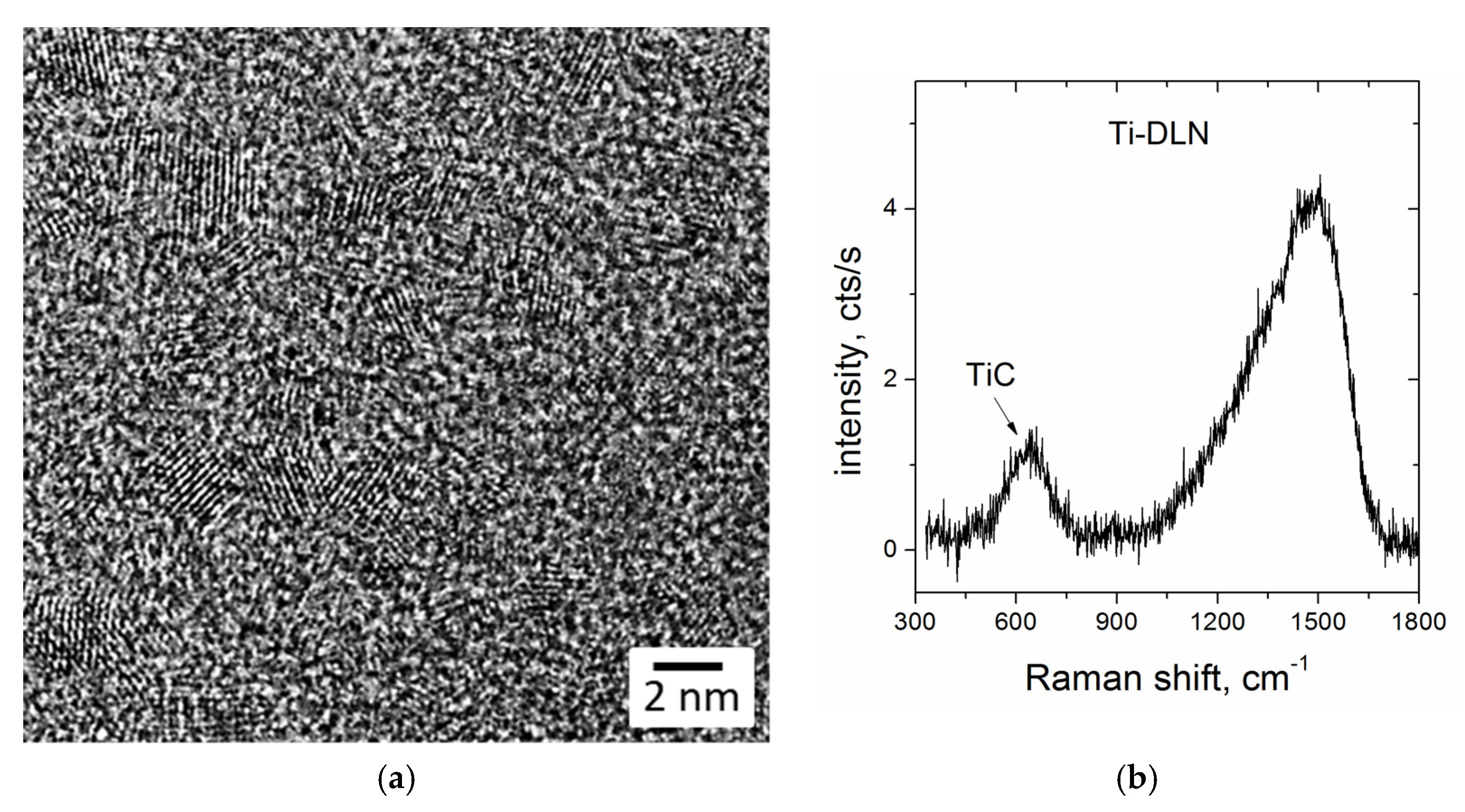
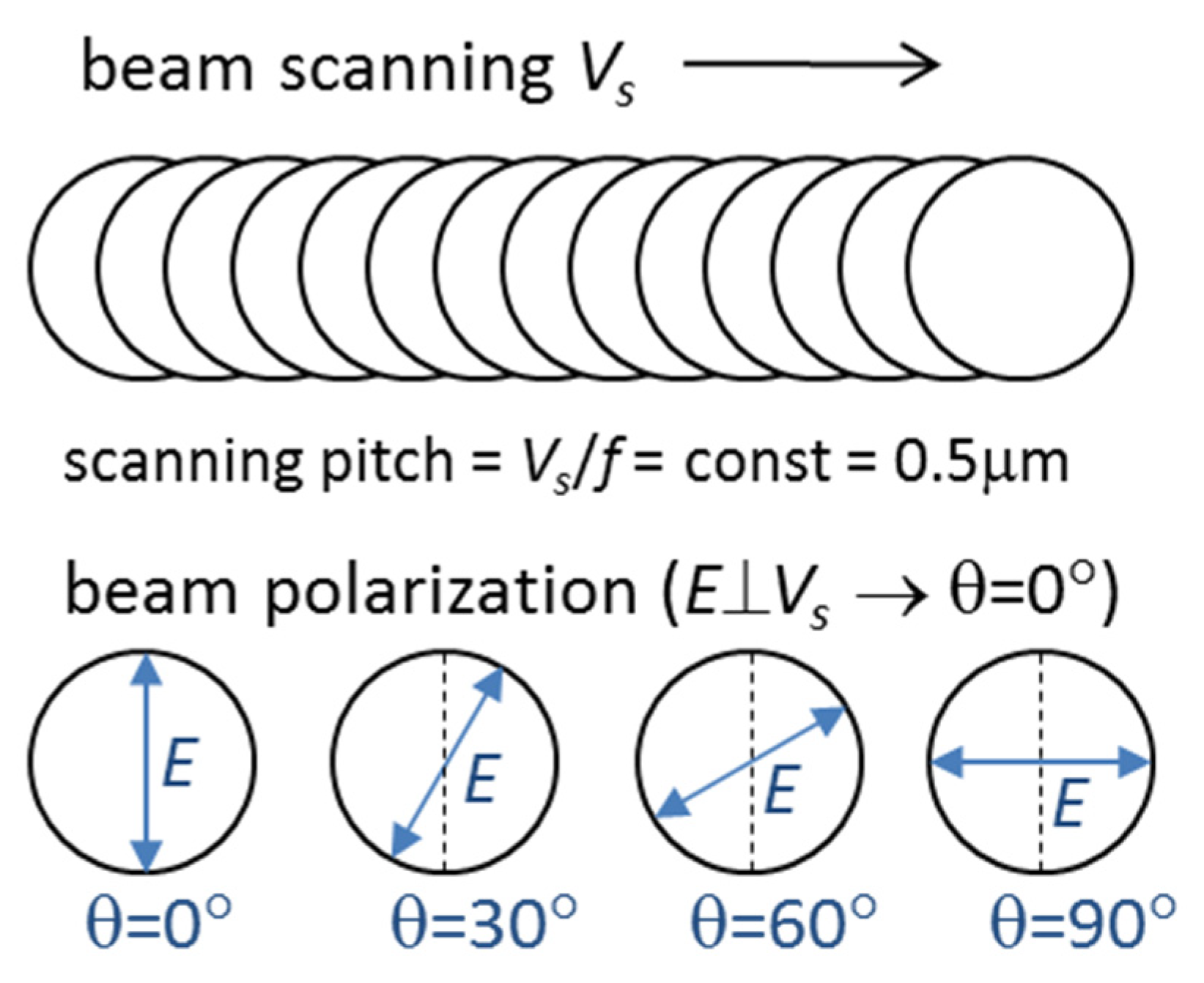

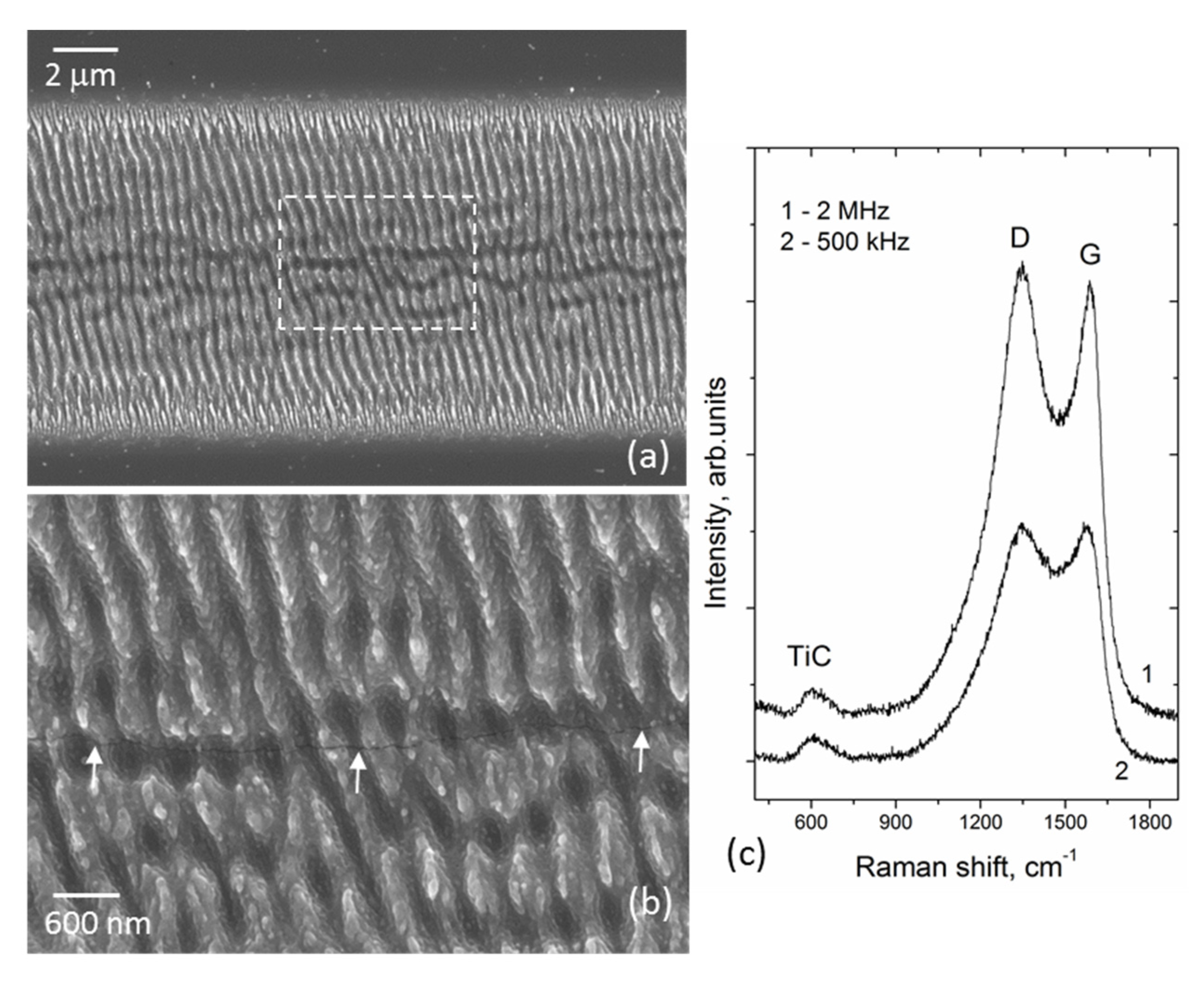
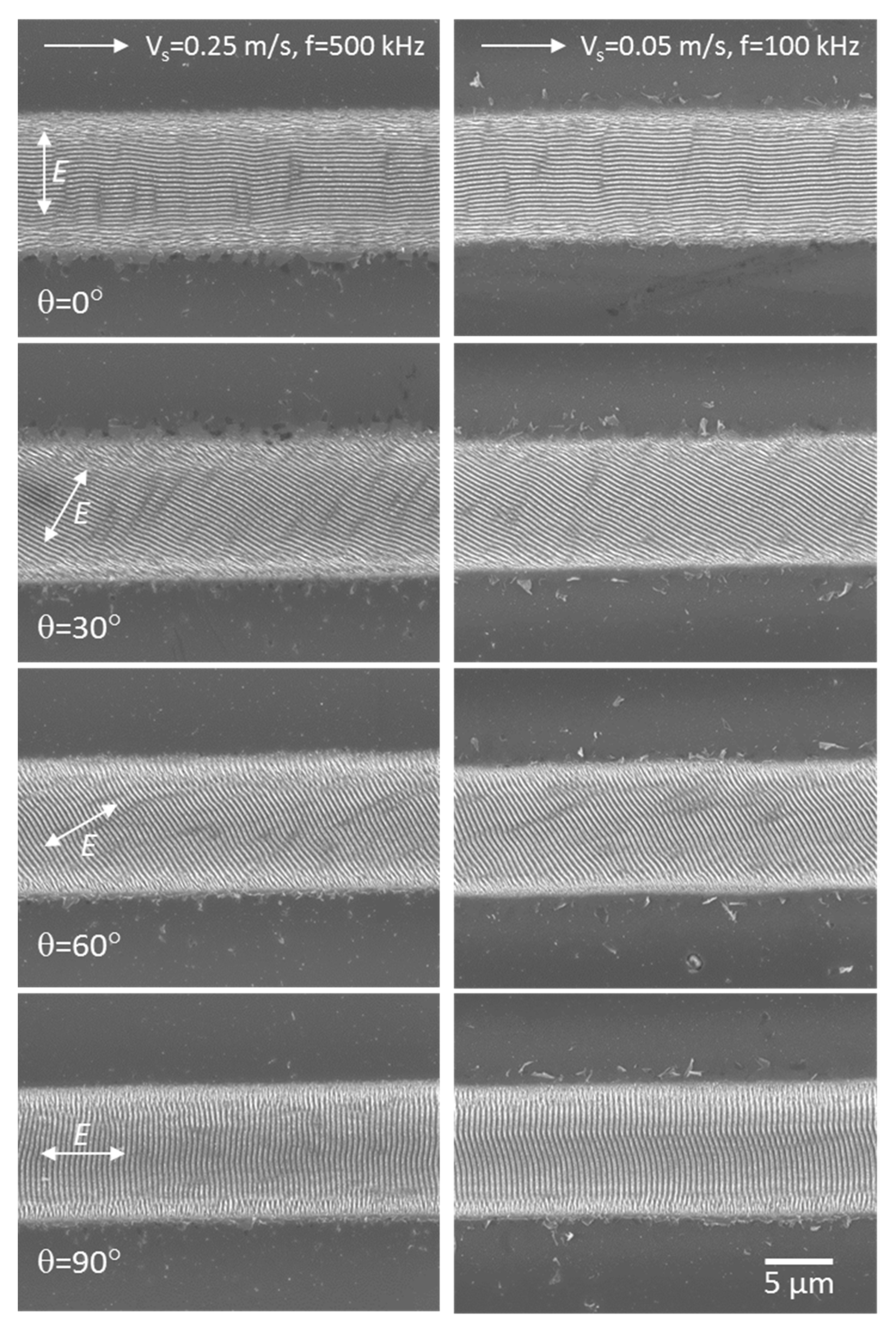
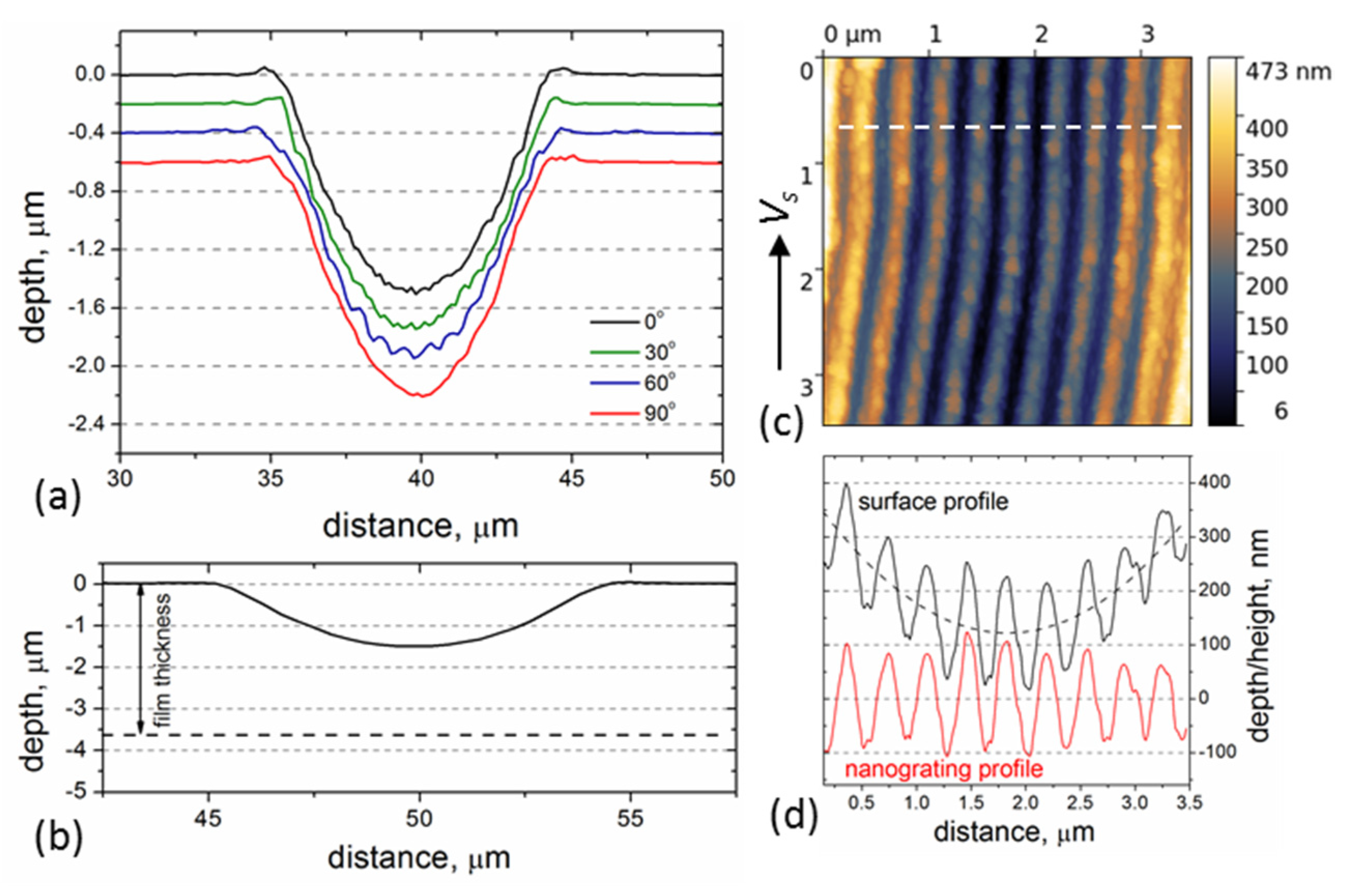



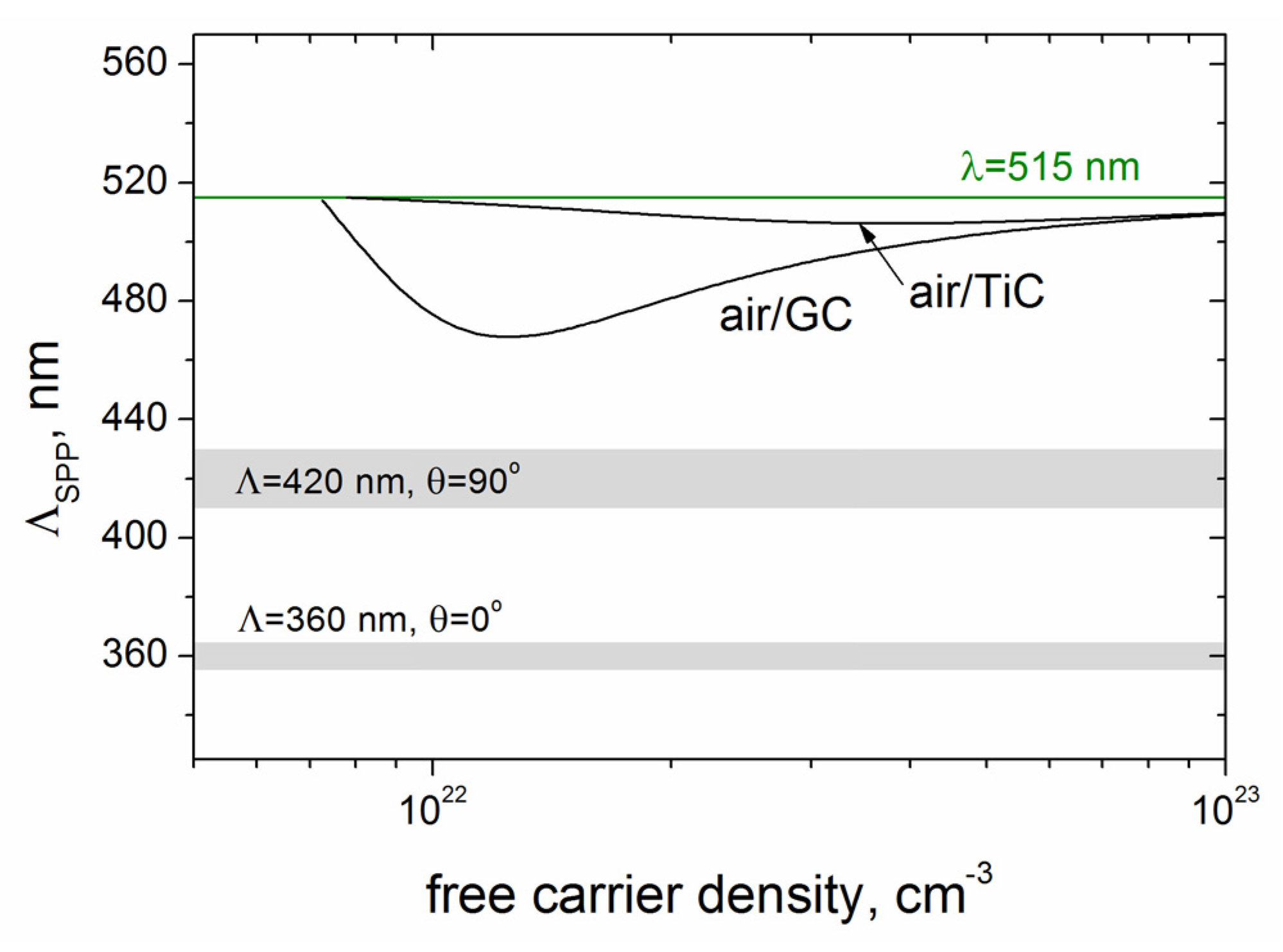
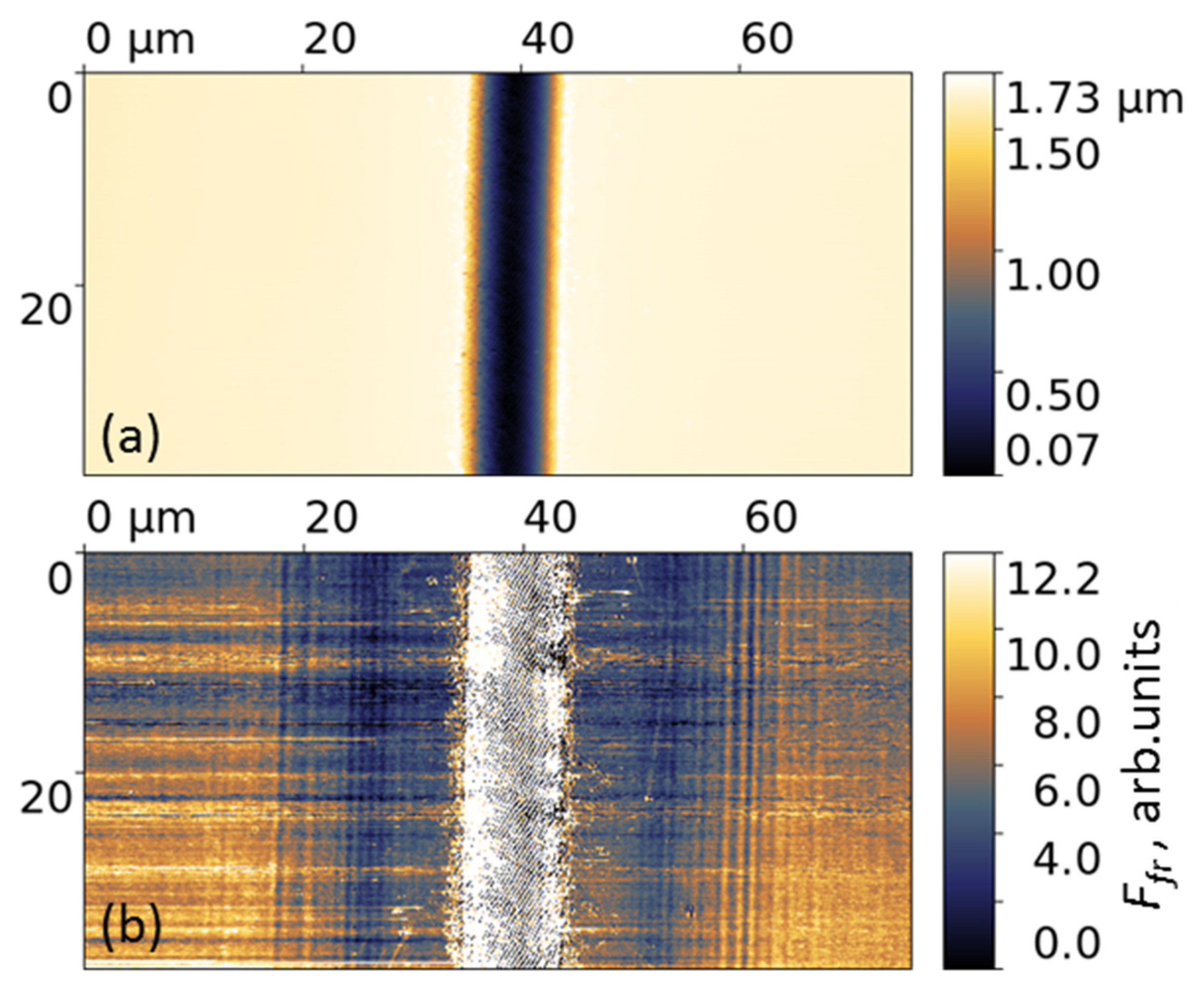
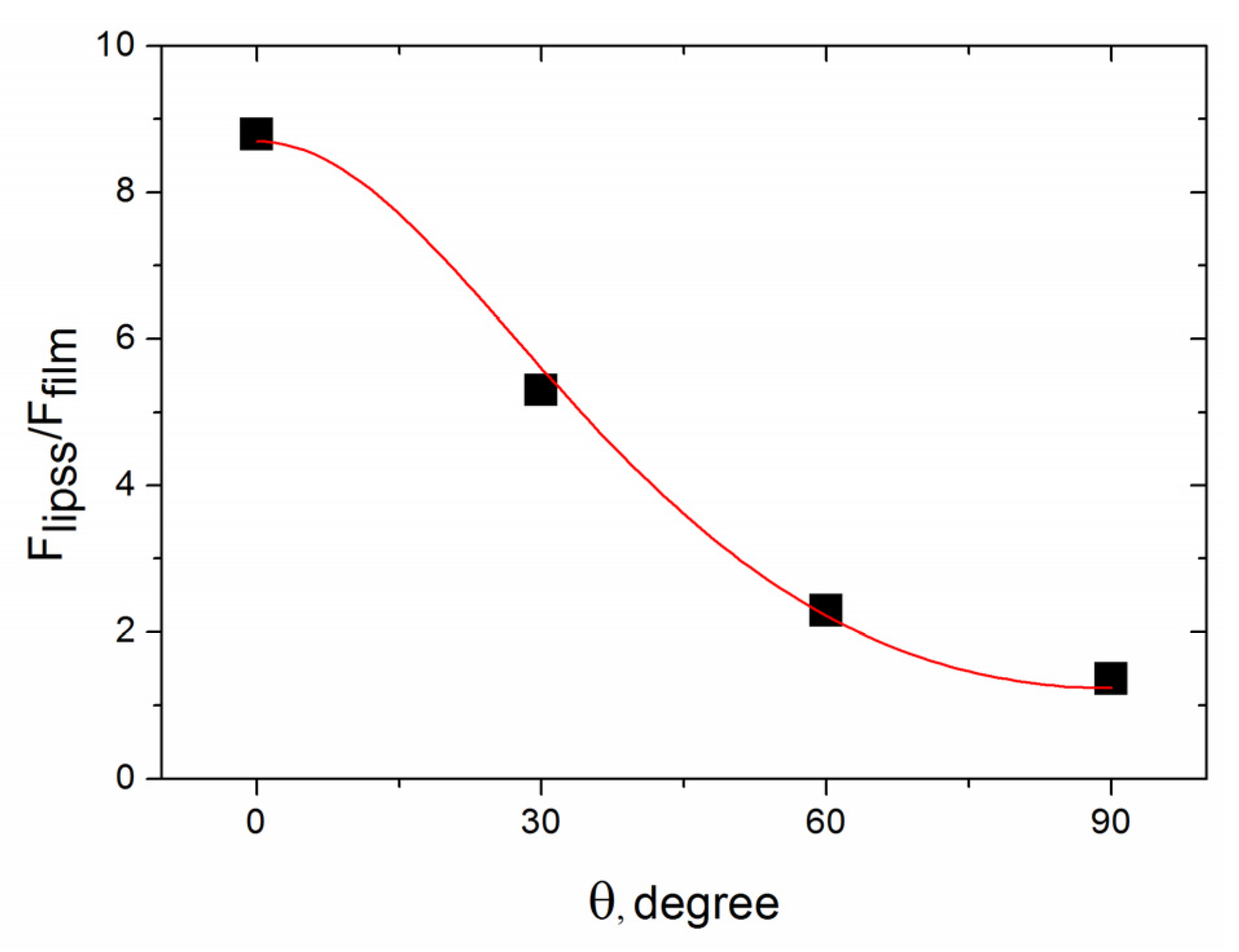
Disclaimer/Publisher’s Note: The statements, opinions and data contained in all publications are solely those of the individual author(s) and contributor(s) and not of MDPI and/or the editor(s). MDPI and/or the editor(s) disclaim responsibility for any injury to people or property resulting from any ideas, methods, instructions or products referred to in the content. |
© 2023 by the authors. Licensee MDPI, Basel, Switzerland. This article is an open access article distributed under the terms and conditions of the Creative Commons Attribution (CC BY) license (https://creativecommons.org/licenses/by/4.0/).
Share and Cite
Pimenov, S.M.; Zavedeev, E.V.; Jaeggi, B.; Neuenschwander, B. Femtosecond Laser-Induced Periodic Surface Structures in Titanium-Doped Diamond-like Nanocomposite Films: Effects of the Beam Polarization Rotation. Materials 2023, 16, 795. https://doi.org/10.3390/ma16020795
Pimenov SM, Zavedeev EV, Jaeggi B, Neuenschwander B. Femtosecond Laser-Induced Periodic Surface Structures in Titanium-Doped Diamond-like Nanocomposite Films: Effects of the Beam Polarization Rotation. Materials. 2023; 16(2):795. https://doi.org/10.3390/ma16020795
Chicago/Turabian StylePimenov, Sergei M., Evgeny V. Zavedeev, Beat Jaeggi, and Beat Neuenschwander. 2023. "Femtosecond Laser-Induced Periodic Surface Structures in Titanium-Doped Diamond-like Nanocomposite Films: Effects of the Beam Polarization Rotation" Materials 16, no. 2: 795. https://doi.org/10.3390/ma16020795




